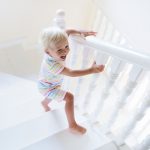 Playing with bubbles is probably a favorite pastime from your childhood, and it might be becoming one of your child’s favorites, too. Aside from adding lots of fun to a toddler’s day, bubbles have another purpose: They help your little one develop gross motor skills in several ways! From his arms and legs down to his feet, his whole body can move and play with bubbles.
Playing with bubbles is probably a favorite pastime from your childhood, and it might be becoming one of your child’s favorites, too. Aside from adding lots of fun to a toddler’s day, bubbles have another purpose: They help your little one develop gross motor skills in several ways! From his arms and legs down to his feet, his whole body can move and play with bubbles.
Highlights:
|
Bubble play can give your toddler similar gross motor benefits as sports! Here’s a snapshot:
Reaching. What do little ones want to do when they see bubbles? Pop them! You’ll see your toddler stretching and reaching to try to grab and pop those bubbles that float over his head, which is a good way to get his arm and trunk muscles stretched out and limber. As he reaches, he may even go up on the tips of his toes to stretch and work the leg and feet muscles, too.
Running and jumping. Your toddler can chase floating bubbles, run away from bubbles coming toward him, or jump over those that are moving close to his feet. This gets his legs and feet moving forward, backward, and off the ground quickly, and builds muscle along the way.
Agility. As your toddler twists, turns, and moves to dodge or catch bubbles, he’s building agility. Agility works together with balance, another key skill that develops throughout the toddler years, to help him remain steady during his movements.
Kicking or stomping. Stomping bubbles is always a fun task, but it also develops coordination. Your child has to use his feet and eyes together to make contact with each bubble he wants to stomp. The same applies to kicking bubbles that come close to his feet, just like he would a soccer ball.
Hand-eye and foot-eye coordination. Hand-eye and foot-eye coordination refer to your toddler’s ability to track with his eyes to help his hands and feet follow through with an action. In the case of bubble play, he’ll use his eyes to watch the bubbles as they float in all directions as he figures out what to do with his arms, hands, legs, and feet, such as pop bubbles with his fingertips, run toward the bubbles, or stomp on them.
Midline crossing. Your toddler may reach his left arm across his body to pop a bubble that’s closer to his right side. This targets midline crossing, which strengthens his torso and improves coordination across both sides of his body.
Hand/arm and foot/leg dominance. Bubble play is an excellent way to get the hands, arms, feet, and legs working in several ways. The more your toddler uses his limbs, the closer he’ll get to establishing a dominant hand and foot, although he may not have a clear pick for several more years. Foot and hand dominance allows children to use one foot/leg and hand/arm as their primary “worker” and the other as a “helper” to complete tasks like writing, kicking, and turning more efficiently.
Don’t forget to take your toddler’s shoes off once in a while if you’re play outside with bubbles (as long as you’re not on a surface that could become slippery). Being barefoot can be beneficial for developing the feet and improving agility.








